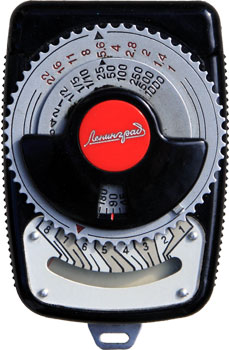
|
  Maker: Leningrad Model: YU 11 (ю 11) Circa: 1950 Cell type: Selenium Measure type: reflecting/averaging; 2D incident with attachment |
|
Russian stuff is probably the most difficult to research. The vast gulf in language and culture is bad enough; add the fact that they were a closed society for decades and publishing their product history was a non-existent priority. Add the fact that even though there were "companies," everything was state-owned and products could be developed here, produced there, and moved here there and elsewhere at the whim of a government beaurocrat who had the power to make it happen for any reason he saw fit. It's tough to learn much about Russian equipment. This is a Leningrad 1, officially just a Leningrad since its successors hadn't come out yet (there would be several). It got its name from the city where it was made, in the "Vibrator factory" (a vibrator is an electromechanical device; old tube-type car radios used them). This was common practice in Russia: there are Moscow and Sverdlovsk meters as well. It bears a very strong resemblance to Metrawatt products, in particular the Horvex 2. The Russians didn't like to spend much on R&D for civilian goods; I believe they took Metrawatt designs and tweaked them for Russian consumption. Another tell-tale: on the back there are two extra holes which match up to the width of the holes on the Horvex 2, which is where you plug the auxiliary booster in. The Horvex has a mark on the dial to compensate if you are using the booster. This one lacks that mark so I believe it was never intended to take the accessory—but the electronics may be there for it anyway. Someday I'll get the booster and try it out. It's not exactly a Horvex 2, though. The casing is a little different and it lacks the little finger notches on the case sides underneath the dial. I suspect that this is an earlier Metrawatt model rather than the Horvex 2—one that didn't get exported to the West. On this meter, everything's in cyrillic and the film speed index is GOST (which means "state standard"). GOST was a geometric-progression speed and closely analgous to ASA. The export versions had the roman alphabet and ASA instead of GOST. Most likely the domestic and import meters are identical except for the case markings, and the calculator wheel's GOST and ASA scales are identical. If I ever pick up an import version of this meter, I'll be able to confirm it. Mine came in a box with a Passport, which appears to be a certificate of ownership like a warranty card. No instructions, but with a meter like this, you don't really need it. The writing is in Russian, of course, but that just makes it more fun. Here is a cross-reference chart for film speeds (ASA / ISO / DIN / GOST / others) . |
|
©opyright by James Ollinger. All Rights Reserved.
Company names and models are registered trademarks of their respective owners
and are not affiliated with this website in any way.
